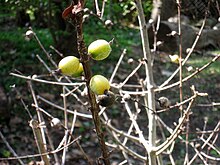Rosenbergiodendron formosum
| Rosenbergiodendron formosum | ||||||||||||
|---|---|---|---|---|---|---|---|---|---|---|---|---|

Rosenbergiodendron formosum |
||||||||||||
| Systematics | ||||||||||||
|
||||||||||||
| Scientific name | ||||||||||||
| Rosenbergiodendron formosum | ||||||||||||
| ( Jacq. ) Fagerl. |
Rosenbergiodendron formosum is a species of plant in the red family from Ecuador , Venezuela , Colombia and Panama . The generic name honors the Swedish botanist Gustaf Otto Rosenberg (1872–1948).
description
Rosenbergiodendron formosum grows as a deciduous and richly branched shrub up to about 4 meters high. The relatively smooth bark is grayish-brown.
The simple and short-stalked, leathery, firm leaves are arranged (cross) opposite to whorled. The short petiole is up to 0.5–1 centimeters long. The slightly to slightly hairy and obovate to elliptical leaves are up to 9-11 inches long and 3-4 inches wide. They are entire and pointed to pointed at the tip, with a slightly sloping blade. There are small and overgrown, triangular stipules . Tiny colleters are present in the calyx and on the stipules .
The white-green, (almost) sessile and very long, five-fold, hermaphroditic, strongly scented flowers with a double flower envelope appear solitary and terminal or axillary. The small, hairy calyx, softly pressed on the outside, with awlish tips, is up to 1.7–2 centimeters long. The salver-shaped crown is up to 11-13 centimeters long. The long, narrow-tubular corolla-tube is more or less soft and hairy on the outside. The lanceolate and pointed tips are up to 3–6 centimeters long. The 5 tightly enclosed and short, almost sedentary stamens are attached to the slightly widened throat above. The two-chamber ovary is inferior in short, soft hairy flower cups , with a long, slightly above, slightly hairy in the upper part stylus having a relatively large, zweilappiger scar . There is a bare discus .
Multi-seeded and yellow, about 2.5–4 centimeters long, egg-shaped to ellipsoidal, slightly whitish or brownish speckled, slightly hairy berries ( false fruit , cranberry) with a thick, firm skin and a permanent calyx are formed. The flat, egg-shaped and brown, 5-8 millimeter long seeds are each individually in a blackish, gelatinous pulp.
Systematics
One can distinguish between two varieties:
- Rosenbergiodendron formosum var. Formosum : It occurs from Panama to northwestern Venezuela and western Ecuador.
- Rosenbergiodendron formosum var. Nitidum (K.Schum.) C.Gust. : It only occurs in Venezuela.
use
The sweet fruits are edible, they are used raw or cooked.
literature
- Claes GR Gustafsson: The Neotropical Rosenbergiodendron (Rubiaceae, Gardenieae). In: Brittonia. Vol. 50, No. 4, 1998, pp. 452-466, doi: 10.2307 / 2807754 .
Web links
- Rosenbergiodendron formosum at Useful Tropical Plants.
- Blackberry Jam Fruit at Growables.
Individual evidence
- ↑ a b c d Rafaël Govaerts (Ed.): Rosenbergiodendron formosum. In: World Checklist of Selected Plant Families (WCSP) - The Board of Trustees of the Royal Botanic Gardens, Kew . Retrieved June 2, 2020.
- ↑ Lotte Burkhardt: Directory of eponymous plant names - Extended Edition. Part I and II. Botanic Garden and Botanical Museum Berlin , Freie Universität Berlin , Berlin 2018, ISBN 978-3-946292-26-5 , doi: 10.3372 / epolist2018 .
